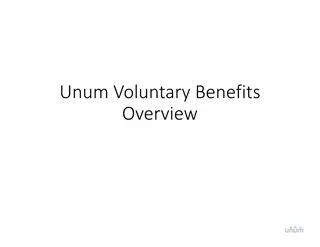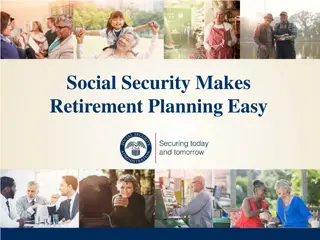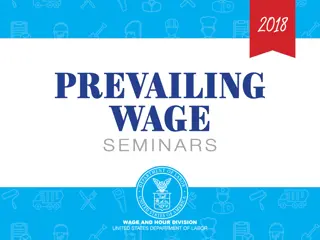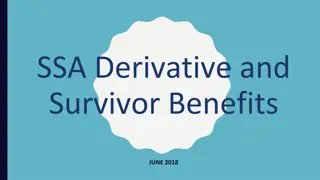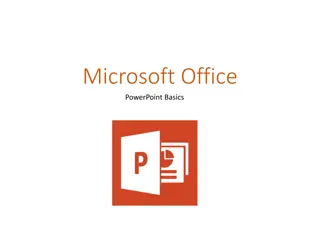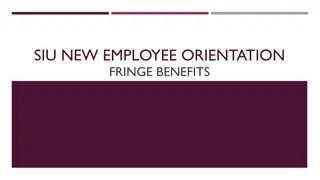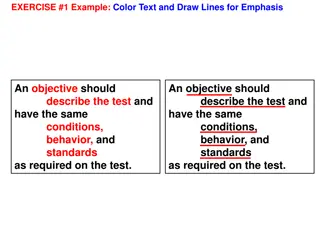
Veterans Affairs Benefits Overview: Pension, Compensation, Eligibility
Learn about various Veterans Affairs benefits such as pension, compensation, eligibility criteria, and service-connected benefits for dependents. Understand the requirements for receiving benefits, including time in service, disability criteria, income thresholds, and wartime service periods.
Download Presentation

Please find below an Image/Link to download the presentation.
The content on the website is provided AS IS for your information and personal use only. It may not be sold, licensed, or shared on other websites without obtaining consent from the author. If you encounter any issues during the download, it is possible that the publisher has removed the file from their server.
You are allowed to download the files provided on this website for personal or commercial use, subject to the condition that they are used lawfully. All files are the property of their respective owners.
The content on the website is provided AS IS for your information and personal use only. It may not be sold, licensed, or shared on other websites without obtaining consent from the author.
E N D
Presentation Transcript
VA Benefits Pension Not service-connected Means tested Compensation Service connected Notmeans tested Benefits for Dependents (DIC and Survivors Pension) Health Care Education and Training Home Loan Guaranty Life Insurance Burialand Memorial Services
Basic eligibility: Veteran status Federal: Army, Navy, Air Force, Marines, Coast Guard. National Guard only if federalized. Active: Reserve only if mobilized. Honorable service: A person who has served in the active military, naval or air service, and who was discharged under conditions other than dishonorable. (38 USC 101, 38 CFR 3.12(a, d), emphasis added.) No statutory bars: 38 CFR 3.12(b, c) Conscientious objector, general court martial, deserter, AWOL > 180 days unless mitigated
VA Character of Discharge evaluation Discharged or released under conditions other than dishonorable. 38 USC 101(2) Characters of service: Honorable General(under honorable conditions) Other than Honorable or Undesirable Bad Conduct Dishonorable Uncharacterized
Pension: Eligibility Veteran status. Time in service: Prior to 1980: 90 days Since September 1980 At least 24 continuous months, or Completion of time ordered to active duty, or Compensable service-connected disability. Disabled: Permanently disabled for any reason (SSI usually sufficient), or At least 65 years old. Low-income: monthly income under $1,097 (current pension rate as of 12/01/17); assets under ~ $70k. Income can be offset by some expenses, and some exempt assets. Wartime service: At least one day during a declared wartime.
Pension WartimePeriods Wartimeperiod Start End World War II December 7, 1941 December 31, 1946 Korean Conflict June 27, 1950 January 31, 1955 Vietnam Era August5, 1964 May 7, 1975 Vietnam Era if in theater February8, 1961 May 7, 1975 (TBD) Persian Gulf War August2, 1990
Compensation 38 USC 1110, 1131 Compensate reduction in earning capacity caused by military service. Awarded on percentage basis, 0% 100% in 10% increments. Not each disability is ratable at each increment. Monthlypayments. Taxfree.
Compensation: Eligibility Veteran status. No time in service requirements. Service connection: current disability incurred or aggravated during service. Rating: evaluation of present impairment.
Compensation: Service connection Tohave a viable claim for service connected disability compensation you need the following three elements: An in-service event, injury, or diagnosis;plus a current diseaseor disability;and a nexus between the two. 1. 2. 3.
Compensation: In-service injury or illness Incurred in or aggravated during military service. As shownby: Lay evidence of event, corroboratedby objective evidence. Special standardsfor events in combat and for PTSD. 38 CFR 3.204 (d, f) Medical evidence of illnessduring service. Medical evidence of illness during a presumptive period. CFR 3.307, 3.309 Presumption of soundness. 38 Not a result of willful misconduct. 38 CFR 3.301
Compensation: Current disability Current diagnosis Use DSM-V for mental disability Non-compensable: Personality disorders Adjustmentdisorders
Compensation: Nexus Causal relationship between in-service injury and present disability. Theories of service connection: Direct Typically requires continuity of treatment. Chronic = permanent. Does not require continuity of treatment. Presumptive No nexus required. 38 CFR 3.307-309 Secondary. Conditionis a result of another condition that is already service-connected. May include substance abuse for mental health disabilities. 1151. Disability due to VAmalpractice. 39 USC 1151 Competent evidence. Must be medical opinion. May use treatise evidence, but not given much weight. Standard. Atleast as likely as not (50% or greater).
Compensation Rates: (as of 1/21/22) Rating Compensation Rating Compensation 10% $152.64 60% $1,214.03 20% $301.74 70% $1,529.95 30% $467.39 80% $1,778.43 40% $673.28 90% $1,998.52 50% $958.44 100% $3,332.06 Veteran only rates listed rates vary with dependent status Full rate list is available here
Compensation Rates Criteria. Measuresfunctional loss Based on schedule 38 CFR 4.40 et seq. Duration. Can be temporary or permanent Combiningratings. Consider it like a discount on a discount. No pyramiding. 38 CFR 4.14 38CFR 4.25 Supplements Total Disability for Individual Unemployability (TDIU). If one disability is rated 60%, or multiples add up to 70%, then may increase to 100% if combination of disabilities allows no or marginal employment. 38 CFR 4.16-17, VA Form21-8940 Special Monthly Compensation.
What is Aide and Attendance? VA may provide additional income in the form of an allowance to the basic benefit if the Veteran or the surviving spouse has a regular medical need for assistance or supervision due to disability. Allowances are granted for the regular need for "aide and attendance" or if the beneficiary is "housebound. Special Note: Aide and Attendance is an allowance paid in addition to the basic benefits of compensation or pension. It is not a separate or stand-alone program. 15
What is Aide and Attendance? (continued) The Aid and Attendance allowance is paid because a person, due to mental or physical disability, requires the regular aid and attendance of another person in conducting the basic activities of daily living, such as bathing dressing, and going to the bathroom Entitlement to the Aid and Attendance allowance extends to the Veteran, spouse, surviving parent(s), or surviving spouse. References: 38 CFR 3.350 and 38 CFR 3.351 16
What is Aide and Attendance? (continued) Aid and Attendance may be granted when one or more conditions exists that requires additional caregiver support for the disability. Medical evidence is required unless someone is a patient in a nursing home, and then the requirement is waived. Submit VA Form 21-2680, Examination for Housebound Status or Permanent need for Regular Aid and Attendance 17
What is Aide and Attendance? (continued) HOW MUCH DOES VA PAY? Service-Connected / Compensation $2,973.86 100% disability compensation (for a single Veteran) $3,328.70 Housebound (for a single Veteran) $3,700.43 Aid and Attendance (for a single Veteran) Non Service-Connected / Pension $1,097.16 Maximum Annual Pension Rate (single Veteran) $1,340.75 Housebound (max household income $16,089) $1,830.16 Aid and Attendance (max household income $21,962) 18
Benefits for Dependents Dependency and Indemnity Compensation (DIC) Monthly benefit paid to eligible survivors. Service member whodied onactive duty. Veteran whose death resulted from a service connectedcondition. Veteran whose death did not result from a service connected condition, but who was had been receiving disability compensation and rated totally and disabled for the 10 years immediately before death. Survivors Pension ( Death Pension ) Monthly benefit for low-income unremarried surviving spouse and/or unmarried child(ren) of veteran with wartime service. Current maximum rate of $735 per month. Please note, this list is not exhaustive, so please check the regulations if contacted by a dependent.
How to make a claim? Original. (VA Form 21-526for Pension or Compensation) Fully Developed Claim. (VAForm 21-526EZ) Reopened. Requiresnew and material evidence. CUE Clear and unmistakable error . a legal error in the original decisionthat determined an unfavorable outcome. retroactive to the date of original claim. May mean benefits are
Administrative Appeals Noticeof disagreement Within 1 year of decision. State basis for disagreement. Include additional evidence or argument. DRO review and hearing are optional. Statement of the Case (SOC) Outline of issues,law and evidence. Notice of Right to Appeal. VA Form 9 Appeal to Board of Veterans Appeals . BVAhearing Single judge. Usually results in a remand to the Regional Office. If an unfavorable decision at the BVA level, an appeal is made to the Court of Appeals for Veterans Claims (CAVC), which removes the claim out of the VA Administrative System.
Overview Claims Process Informalclaim FormalClaim (1 yeardeadline) CompensationandPension(C&P) Exam RatingDecision Initial Claim Noticeof Disagreement(1 yeardeadline) Decision Review Officer (RDO) review. De novo.Optional. With hearingif requested. Statementof the Case(SOC) SupplementaryStatementof the Case(SSOC) Regional Office Appeal Form9 (60daydeadline) BVA hearing: in person or teleconference. De novo. Decision, usuallywithremand. Board for Veterans Appeals (BVA) Courtof Appeal for Veterans Claims(CAVC)(120day deadline) FederalCircuit SCOTUS Judicial Review
Tips and pointers Dates matter! Be sure to maintain confirmation dates of all documents submitted to the VA. The VA will misplace or lose a document you have submitted. Until you reach the BVA level, your audience is a lay person with no legal training. Write accordingly and keep it simple. Sources of authority: 38 CFR BVA and CAVC case law M21-1MR manual
Tips and pointers (cont.) Check before filing if a specific form is necessary and use the most current version of any form you submit. Rely on the Disability Benefits Questionnaires (DBQ). Veterans Benefits Manual is an essential tool, published annually by LexisNexis and available at the San Francisco Law Library.
Representation of Vets: Accreditation. Toassist a veteran with a claim for benefits,you must be accredited by the VA. See 38 C.F.R. 14.626, et seq. There is no cost, but there is an application process and continuing education requirements.






